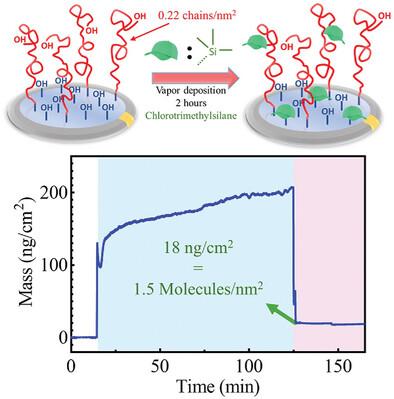全疏性表面接枝聚二甲基硅氧烷链的分子结构
IF 13
2区 材料科学
Q1 CHEMISTRY, MULTIDISCIPLINARY
引用次数: 0
摘要
接枝聚二甲基硅氧烷(PDMS)链的独特表面特性,尤其是其疏水性和低摩擦性,受到分子结构和系链密度的影响。尽管分子结构光滑、均匀,但这些表面在润湿性和接触角滞后(CAH)方面却表现出显著的差异性。这项研究揭示了接枝 PDMS 链的分子结构。使用双官能团氯硅烷引发剂合成的接枝 PDMS 链在硅晶片上显示出 CAH <2° ,采用刷子到蘑菇的构象,分子量≈7,800 g mol-1,接枝密度为 0.22 ± 0.4 链 nm-2,厚度≈3 nm。每条 PDMS 链的末端都有一个硅烷醇基团,而且≈96% 的底物硅烷醇仍未反应。这些末端硅烷醇的存在可通过飞行时间二级离子质谱法得到证实,当与三甲基硅烷基团交换时,基底上和 PDMS 链末端的硅烷醇也会被清除。石英晶体微天平与耗散测量结果表明,这种 "封端 "过程可交换≈1.5 个硅烷醇 nm-2;封端发生在基底和 PDMS 链端。研究结果表明,这种分子量的接枝、封端 PDMS 链即使在大部分表面硅烷醇仍未反应的情况下也能实现出色的疏油特性,这可能有助于未来疏油材料的设计。本文章由计算机程序翻译,如有差异,请以英文原文为准。

Molecular Structure of Omniphobic, Surface-Grafted Polydimethylsiloxane Chains
The unique surface properties of grafted polydimethylsiloxane (PDMS) chains, particularly their omniphobicity and low friction, are influenced by molecular structure and tethering density. Despite molecularly smoothness and homogeneity, these surfaces exhibit significant variability in wettability and contact angle hysteresis (CAH). This work uncovers the molecular structure of grafted PDMS chains. Grafted PDMS chains synthesized using a difunctional chlorosilane initiator, which exhibits CAH <2° on silicon wafers, adopt a brush-to-mushroom conformation with a molecular weight ≈7,800 g mol−1, a grafting density of 0.22 ± 0.4 chains nm−2, and a thickness of ≈3 nm. Each PDMS chain terminates with a silanol group, and ≈96% of substrate silanols remain unreacted. The presence of these terminal silanols is confirmed with time-of-flight secondary ion mass spectroscopy, as is their removal when exchanged for trimethylsilyl groups, both on the substrate and terminating the PDMS chains. Quartz crystal microbalance with dissipation measurements show that this “capping” procedure exchanges ≈1.5 silanols nm−2; capping occurs at the substrate and PDMS chain end. The findings suggest that grafted, capped PDMS chains of this molecular weight are able to achieve excellent omniphobic properties even when the majority of surface silanols remain unreacted, which may aid in the design of future omniphobic materials.
求助全文
通过发布文献求助,成功后即可免费获取论文全文。
去求助
来源期刊

Small
工程技术-材料科学:综合
CiteScore
17.70
自引率
3.80%
发文量
1830
审稿时长
2.1 months
期刊介绍:
Small serves as an exceptional platform for both experimental and theoretical studies in fundamental and applied interdisciplinary research at the nano- and microscale. The journal offers a compelling mix of peer-reviewed Research Articles, Reviews, Perspectives, and Comments.
With a remarkable 2022 Journal Impact Factor of 13.3 (Journal Citation Reports from Clarivate Analytics, 2023), Small remains among the top multidisciplinary journals, covering a wide range of topics at the interface of materials science, chemistry, physics, engineering, medicine, and biology.
Small's readership includes biochemists, biologists, biomedical scientists, chemists, engineers, information technologists, materials scientists, physicists, and theoreticians alike.
 求助内容:
求助内容: 应助结果提醒方式:
应助结果提醒方式:


